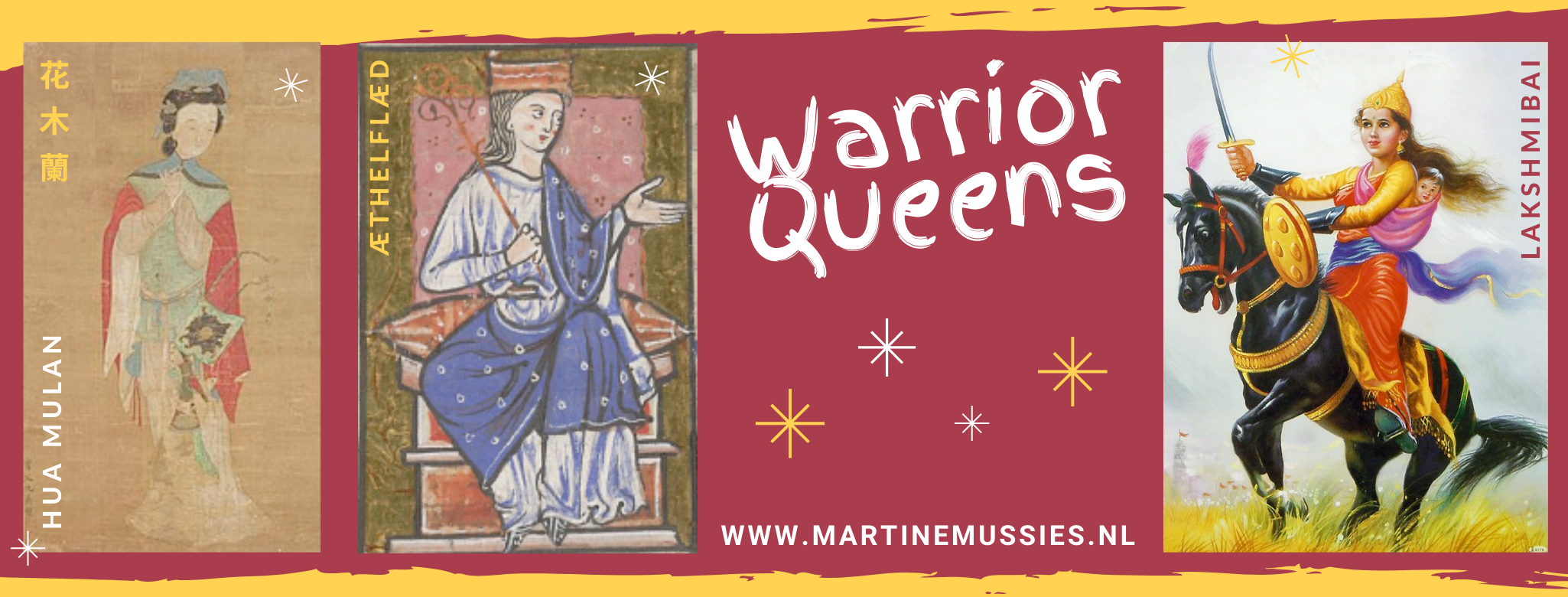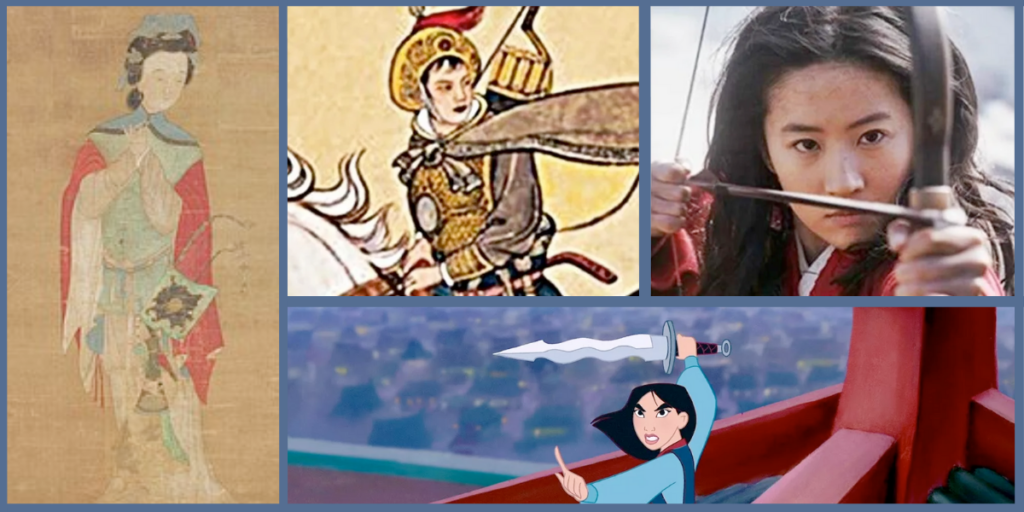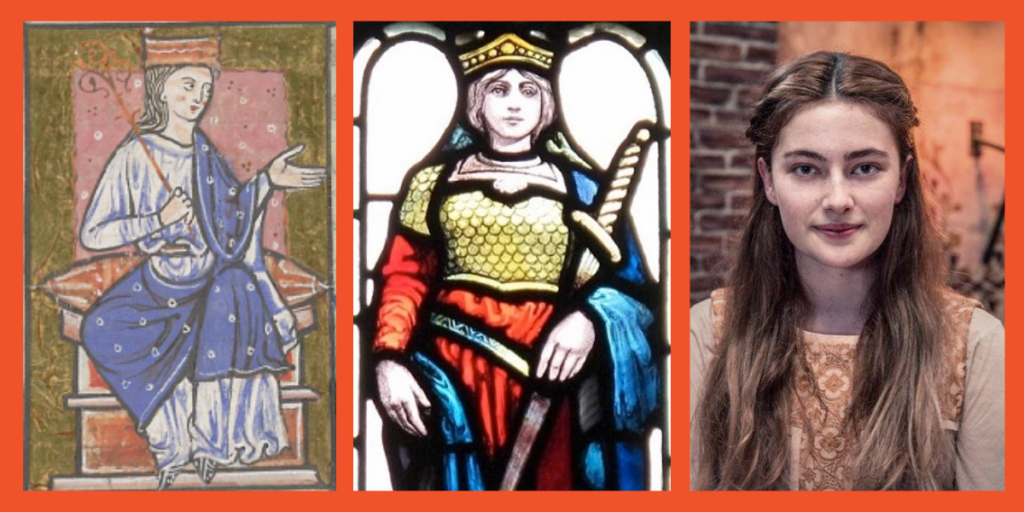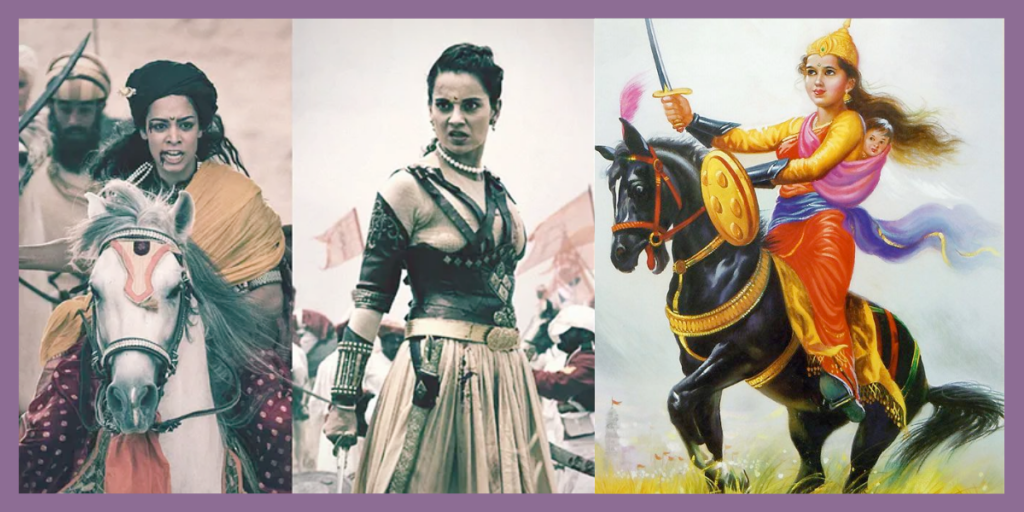Three Warrior Queens

In answer to my feminist friends, I researched three inspiring Warrior Queens: Hua Mulan (4th to 6th century AD), Æthelflæd (c. 870-918), and Lakshmibai (1828-1858). An abridged version of this post was also published here, in the “Representation Matters” category of Geek Girl Authority.
Warrior Queens
As all my friends know, I take a special interest in Alfred the Great. Not everyone is equally enthusiastic about this. Apart from my endless monologues about my King and the binge-watching of all the Netflix series in which he appears, my feminist friends often ask me the question: why a man? And – as with any special interest – I don’t know.
Although I often see them coming these days – oh hello Mr. Tolkien! – it is hard for me to find out how it has developed from an ordinary hobby to an autistic obsession. Nonetheless, I can think of reasons why I particularly like King Alfred, as he is associated with many other things I like, such as medieval history, languages and translations, martial arts, theories of friendship, mythmaking and storytelling, TV series, art and music.
Nontheless, my friends’ question ignited in me a wish to ‘cherchez la femme’ – and find female role models who can also be linked to all the keywords in the list above. Luckily, I found many mighty women and with this blog post, I would like to introduce you to three inspiring warrior queens. In chronological order: Hua Mulan (4th to 6th century AD), Æthelflæd (c. 870-918), and Lakshmibai (1828-1858).

The Warrior Woman
Among my friends, Mulan became popular through Disney’s 1998 animated film of the same name. The film tells the story of a brave female warrior known as Mulan who was a soldier in China during the Northern and Southern dynasties between 420 and 589CE. She disguised herself as a man and joined the army in place of her father who was a sickly veteran conscripted to the army for a second time by Imperial decree (Klimczak, 2020), as she feared that he would be killed in combat.
According to the film, Mulan and the imperial army triumphed over the invading Huns. Also, a romantic relationship grew between Mulan and the army commander, Li Shang. While many were introduced to Mulan’s story through the film, the first known transcription of her tale comes from a folk song from the North Wei Dynasty (Larson, 2020). The song was called the Ballad of Mulan (Banh, 2020). While it is possible that Mulan was a real person, her story is believed to be largely fictional because ballads were written as inspiring tales rather than historical accounts.
The Ballad of Mulan introduces Hua Mulan, a female Chinese warrior who has been an inspiration to many women. Like in the film, Mulan goes to battle disguised as a man so as to protect her father from being drafted into the war (Dong, 2010). The royal decree is that each family produces one member to fight against the Rouran invaders. In the ballad, Mulan heads off to war with the blessings of her parents. She serves the army for 12 years and becomes a skilled and esteemed warrior (Lau, 2020). When the emperor tries to bestow honors upon her for her service, Mulan remains dutiful and retires home to her family.
Notably, there are various unique adaptations of Mulan’s story reinvented by Chinese artists and adapted into books and plays (Mann, 1997). In some versions, Mulan has sisters. In others, she has a younger brother who is still a child hence cannot go to war.
The legend of Mulan is deeply embedded in Chinese folklore. Her dedication to her family and country are highly praised and used to inspire women and girls to pursue achievements outside of traditional gender roles. Moreover, the story of Mulan has been used by scholars to contribute towards discourses in gender and feminism.

The Lady of Mercia
Aethelflaed, popularly known as Lady of the Mercians, was a powerful military and political leader. Being the eldest daughter of King Alfred and his wife, Lady Eahlswith, she was married of at 16 to the Lord of Mercia; Aethelred, so as to secure an alliance between the two kingdoms; Wessex and Mercia (Stafford, 2001). Whereas the women in Wessex had no political power, the Mercians had a tradition of giving female consorts political power in their own right. Consequently, Mercia proved to be ripe ground for Aethelflaed to grow into a strong successful military and political leader. This opportunity was strengthened by the fact that King Alfred allowed all his children similar opportunities to get education and military training. With her political and military acumen, Aethelflaed elevated Mercia to a greater station by staging military campaigns and building projects and treaties; hence she is commemorated as a warrior queen.
Because Aethelred’s health was constantly failing, Aethelflaed co-ruled alongside him in a partnership almost similar to that of the 16th century Catholic monarchs Isabella of Castile and Ferdinand of Aragon. Her exemplary leadership caused the nobles to appoint her sole ruler of the Mercians following Aethelred’s death (Clarkson, 2018). As ruler of the Mercians, Aethelflaed gained the title; Lady of the Mercians. Her operations ranged far and wide; primarily, Aethelflaed oversaw the fortification of settlements against Viking raiders, the construction of ‘burhs’ and several military campaigns against the Danes (Parker, 2018).
Aethelflaed seized the town of Scergeat and pushed back those who had laid siege to Chester by ingeniously dropping boiling beer and bee hives onto the would-be attackers. The warrior queen played part in sending an expedition to Bardney, deep in Danelaw, to Northumbria. Aethelflaed defeated both Welsh and Viking raiders during her reign and made peace with the people of Alba and the Britons (Watson, 2018). She struck east at the 5 boroughs and the Viking stronghold of Derby fell to the Mercians. Through all the above campaigns, Aethelflaed contributed greatly towards forging England (Walker, 2000).
It is unfortunate that Aethelflaed’s achievements were written out of existence in the Anglo Saxon Chronicle. The warrior queen long remained a footnote in British history because her brother, King Edward, airbrushed her from the Anglo Saxon Chronicle after her untimely death in 918 AD (Keynes, 1998). But because the Anglo Saxon Chronicle exists in different versions, most of Aethelflaed’s achievements are contained in a different version of the chronicle. The Mercian register also gives more credit to Aethelflaed. Presently, the warrior queen is celebrated and hailed as a powerful Anglo-Saxon woman, and a strong military and political leader.

The Rani of Jhansi
Lakshmibai, the rani (queen) of Jhansi, is widely remembered as one of the leading figures of the Indian Rebellion of 1857. She was one of the many leaders of the Great Rebellion in 1857-1858 against East India’s company rule. As a rebel leader, Lakshmibai is regarded as a national heroine and an icon of heroic Indian womanhood (David, 2003). Additionally, she is remembered as a symbol of resistance to the British Raj for Indian nationalists.
Rani Lakshmibai was born as Manikarnika Tambe. She received an unusual upbringing for a Brahim girl in the sense that she was trained in martial arts and was proficient in shooting, horsemanship, fencing and mallakhamb – the traditional Indian gymnastics (Javaid, 2020). Manikarnika was married to the maharaja of Jhansi, Gangadhar Rao, and was given the name Lakshmibai. Unfortunately, Lakshmibai was widowed while young and without children. She lost her and her husband’s child four months after it was born.
According to custom, the maharaja adopted a boy as heir. However, the adopted heir was not recognized by the British who proceeded to annex Jhansi in accordance with the doctrine of lapse (Deshpande, 2008). Markedly, the doctrine of lapse was an aggressive policy put in place by the British East India Company which rejected adopted Hindu heirs as legitimate rulers and placed any sovereign Indian states as vassal states under British rule through the company Jhansi would therefore pass into company ownership by default.
Unusual for a woman at her time, Lakshmibai wrote letters to Lord Dalhousie to context the doctrine of lapse and appeal the legitimacy of her adopted son’s claim to the title of Jhansi (Shiny & Wilson, 2019). Lakshmibai’s petitions mostly went unanswered and rejected. In some cases, the agents responsible did not deliver her letters to the intended recipients.
A series of British military campaigns against Jhansi pushed the 22-year old queen to refuse to cede power to the British effectively causing Jhansi to join the mutiny of 1857 (Sen, 2007). Lakshmibai recruited an army, strengthened the defenses of her city and forced alliances with rebel rajas of neighboring Banpur and Shargarh (Toler, 2006). She was proclaimed regent of Jhansi and ruled on behalf of her minor heir. Moreover, she organized troops and assumed charge of the rebels in Bundelkhand region in an organized uprising against the British. Lakshmibai mounted a successful assault on the city fortress of Gwalior and marched on, against the British, to Morar, where she was killed in combat.
On the whole, Lakshmibai remains a symbol of resistance to Indian nationalists and a national heroine. Despite British press attempts to demonize the heroine, Sir Hugh Rose whom Lakshmibai marched against acknowledged her bravery, cleverness, perseverance and generosity to her subordinates (Toler, 2006). He compared the fallen Lakshmibai to Joan of Arc, citing that the aforementioned qualities made her “the most dangerous of all rebel leaders.”
References
Arman, Joanna (2018). The Warrior Queen The Life and Legend of Aethelflaed, Daughter of Alfred the Great. Amberley Publishing.
Banh, J. (2020). #MakeMulanRight: Retracing the Genealogy of Mulan from Ancient Chinese Tale to Disney Classic. In Recasting the Disney Princess (pp.147-162). Lexington.
Clarkson, T. (2018). Æthelflæd: The Lady of the Mercians. John Donald.
David, S. (2003). The Indian Mutiny: 1857. Penguin.
Deshpande, P. (2008). The Making of an Indian Nationalist Archive: Lakshmibai, Jhansi, and 1857. The Journal of Asian Studies 67 (3): 855-879. https://www.jstor.org/stable/20203427
Dong, L. (2010). Mulan’s Legend and Legacy in China and the United States. Temple University Press.
Javaid, J. (2020). Rani Lakshmibai Biography: Birth, Family, Life History and Death. Jagran Josh. https://www.jagranjosh.com/general-knowledge/rani-lakshmibai-biography-1592467437-1
Keynes, S. (1998). “King Alfred and the Mercians”. In Blackburn, M. A. S.; Dumville, D. N. (eds.). Kings, Currency and Alliances: History and Coinage of Southern England in the Ninth Century. Boydell Press.
Klimczak, N. (2020). The Dramatic True Story Behind Disney’s Mulan. Ancient Origins. https://www.ancient-origins.net/history-famous-people/ballad-hua-mulan-legendary-warrior-woman-who-brought-hope-china-005084
Larson, T. (2020). The Real Story of Hua Mulan Is More Impressive Than Any Disney Version. Esquire. https://www.esquire.com/entertainment/movies/a33917170/real-hua-mulan-true-story-facts/
Lau, J. (2020). Who Is the Real Mulan? The Diplomat. https://thediplomat.com/2020/09/who-is-the-real-mulan/
Mann, S. (1997). Precious Records: Women in China’s Long Eighteenth Century. Stanford University Press.
Parker, E. (2018). Beyond the Warrior Queen. History Today. https://www.historytoday.com/archive/out-margins/beyond-warrior-queen
Sen, I. (2007). Inscribing the Rani of Jhansi in Colonial ‘Mutiny’ Fiction. Economic and political weekly 42(19):1754-1761. DOI: 10.2307/4419581
Shiny, C. & Wilson, D. (2019). Life and Personality of Queen Esther and Rani Lakshmibai: A Research. International Journal of Innovative Technology and Exploring Engineering 8(9S2): 492-495.
Stafford, P. (2001). “Political Women in Mercia, Eighth to Early Tenth Centuries”. In Brown, Michelle P.; Farr, Carol A. (eds.). Mercia: An Anglo-Saxon Kingdom in Europe. (pp. 35–49). Leicester University Press.
Toler, P.D. (2006). Who is Manikarnika? The Real Story of the Legendary Hindu Queen Lakshmi Bai. Historynet. https://www.historynet.com/who-is-marnikarnika-legendary-hindu-queen-lakshmi-bai.htm
Walker, I. W. (2000). Mercia and the Making of England. Sutton Publishing.
Watson, G. (2018). Aethelflaed: The warrior queen who broke the glass ceiling. BBC. https://www.bbc.com/news/uk-england-44069889
Leave a Reply